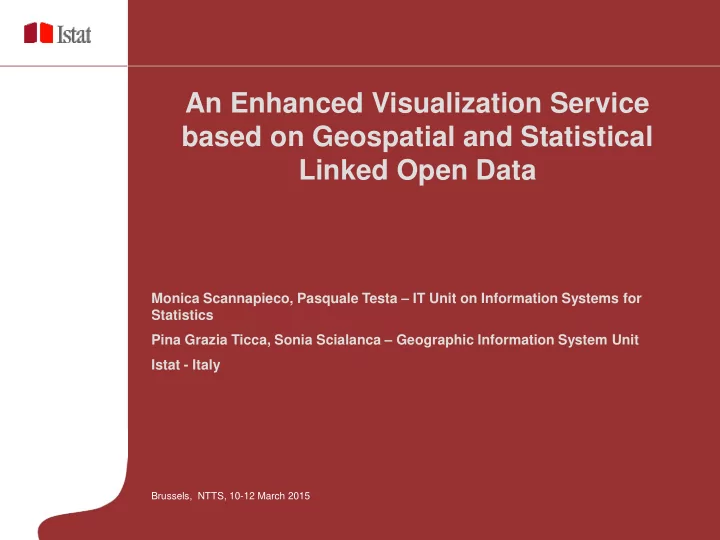

An Enhanced Visualization Service based on Geospatial and Statistical Linked Open Data Monica Scannapieco, Pasquale Testa – IT Unit on Information Systems for Statistics Pina Grazia Ticca, Sonia Scialanca – Geographic Information System Unit Istat - Italy Brussels, NTTS, 10-12 March 2015
Outline Visualization of Geospatial Data – Geographical Information Systems (GISs) – Linked Geo Data Illustration of possible scenarios with implementation examples Conclusions Monica Scannapieco, NTTS, Brussels, 10 -12 March 2015 2
Background: Geographical Information Systems Geographical Information Systems (GISs) enabling interactive visualization, e.g.: – Explore different layers of maps – Zoom in or out – Change visual appearance of maps Monica Scannapieco, NTTS, Brussels, 10 -12 March 2015 3
Background: LOD & Linked Geo Data Family of Semantic Web standards to formal model and query data on the Web – Data Modelling: Resource Description Framework (RDF), RDF Schema, Ontology Web Language (OWL) – Data Querying/ Information Discovery: SPARQL (SPARQL Query Language for RDF) GeoSPARQL - A Geographic Query Language for RDF Data – Modelling and querying of geospatial data Monica Scannapieco, NTTS, Brussels, 10 -12 March 2015 4
Scenario 1: Integrating Linked Open data Platform and GIS Visualization Layer as part of the GIS Monica Scannapieco, NTTS, Brussels, 10 -12 March 2015 5
Scenario 2: Querying of Linked Geo Data Visualization Layer as part of the LOD Portal Monica Scannapieco, NTTS, Brussels, 10 -12 March 2015 6
Implementing Scenario 1 Monica Scannapieco, NTTS, Brussels, 10 -12 March 2015 7
Geospatial data published through MapServices using Gistat platform Geographical layers available Admin areas: Regions, Provinces, Municipalities Census entities: Localities, Enumeration areas, sub- urban areas Basemaps and references maps Monica Scannapieco, NTTS, Brussels, 10 -12 March 2015 8
Example 1: SPARQL results queried by Gistat Selection of commuting indicators (pendolarismo) for all enumeration areas of San Marcello municipality of the region Marche Monica Scannapieco, NTTS, Brussels, 10 -12 March 2015 9
Example 1: Visualization of the query result as a thematic map Sezioni2011 - Filter the EAs Number of commuting pepole (enumeration areas) 2 - 15 16 - 33 Thematic on a 34 - 56 57 - 117 statistic field 118 - 234 Display on top of a reference map Monica Scannapieco, NTTS, Brussels, 10 -12 March 2015 10
Example 2: SPARQL results queried by Gistat Selection of indicators related to families (Famiglie) for all enumeration areas of Terni municipality of the region Umbria Monica Scannapieco, NTTS, Brussels, 10 -12 March 2015 11
Example 2: Visualization of the query result as a thematic map (one-person families -Terni) Filter the EAs Thematic on a statistic field Display on top of a reference map Monica Scannapieco, NTTS, Brussels, 10 -12 March 2015 12
Implementing Scenario 2 Monica Scannapieco, NTTS, Brussels, 10 -12 March 2015 13
Implementation steps Modelling geospatial concepts Mapping geospatial concepts to data Query specification / Visualization Monica Scannapieco, NTTS, Brussels, 10 -12 March 2015 14
Modelling Linked Geo Data Meta Information :Comune rdfs:subClassOf ogc:Feature . :SezCens rdfs:subClassOf ogc:Feature . :exactGeometry rdfs:subPropertyOf ogc:hasGeometry . Non-spatial Properties :Roma rdf:type :Comune . :SezCens1 rdf:type :SezCens . :SezCens1 :haPopolazioneResidente “ 123456"^^xsd:integer . Spatial Properties :SezCens1 :exactGeometry :geo1 . :geo1 ogc:asWKT " Polygon((…))"^^ ogc:wktLiteral . :SezCens1 ogc:sfWithin :Roma . :Roma :exactGeometry :geo2 . :geo2 ogc:asWKT " Polygon((…))"^^ ogc:wktLiteral . Monica Scannapieco, NTTS, Brussels, 10 -12 March 2015 15
Visualization: an example Slippy Map refers to modern web maps which let you zoom and pan around (the map slips around when you drag the mouse) LGD Browser and Editor: http://browser.linkedgeodata.org/ Monica Scannapieco, NTTS, Brussels, 10 -12 March 2015 16
Comparing the two scenarios Visualization Query M-to-M Geospatial and flexibility access Modelling Geospatial efforts Querying Scenario 1 Integrated with Design To be Native GIS time implemented + - - + Scenario 2 Adhoc Query Native To be time implemented - + + - Monica Scannapieco, NTTS, Brussels, 10 -12 March 2015 17
A possible solution: Scenario 1+2 The two architectures are integrated: • On the backend exchangin g data • On the frontend serving different user categories Monica Scannapieco, NTTS, Brussels, 10 -12 March 2015 18
Conclusions Linked Geospatial data are a key point for future spatial web data integration, providing unique URIs and exposing its content as Linked Data Different architectures for visualization of Geospatial linked open data can co-exist in NSIs Questions? Monica Scannapieco, NTTS, Brussels, 10 -12 March 2015 19
Recommend
More recommend